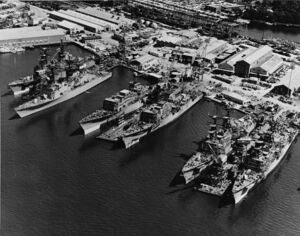Total Package Procurement
Topic: Finance
 From HandWiki - Reading time: 3 min
From HandWiki - Reading time: 3 min
Total Package Procurement (TPP or alternatively TPPC) was a major systems acquisition policy introduced in the United States Department of Defense in the mid-1960s by Secretary of Defense Robert MacNamara.[1] It was conceived by Assistant Secretary of Defense for Installations and Logistics, Robert H. Charles.[2]
TPP involves combining as a single package for the procurement a number of related requirements including the design, development, production and support of major systems.[3] This concept was a "pendulum reaction" to the prior cost reimbursement policies in major weapon systems.[4]
Total Package Procurement was not successful and was abandoned shortly after MacNamara left office.[5][6]
Description
TPP is a method of procuring at the outset of the acquisition phase under a single contract containing price, performance and schedule commitments, the maximum practical amount of design, development, production and support needed to introduce and sustain a system or component in the inventory.[3]
The purpose of TPP was to procure under the influence of competition as much of the total design, development, production and support requirements for a system or component as may be practicable thereby:
- Providing firmer 5-year force structure program package planning information concerning performance cost and schedules.[3]
- Discouraging contractors from buying in on the design and development effort with the intention of recovering on the subsequent production program.[3]
- Permitting program decision and source selection based on binding performance price and schedule commitments by contractors for the total program or major part of it.[3]
- Providing a firmer basis for projecting total acquisition and operational costs for use in source selection and in the determination of appropriate contractual incentives.[3]
- Motivating contractors to design initially for economical production and support of operational hardware which may not receive sufficient emphasis in the absence of productions commitments.[3]
- Requiring contractors to assume more responsibility for program success thereby permitting the Government to monitor programs more in terms of surveillance and less in terms of detailed management.[3]
Results
Total Package Procurement did not succeed.[5] The unique complexity of shipbuilding made Total Package Procurement particularly inappropriate for these programs.[5]
Notable programs that encountered major problems with the TPP approach were the Air Force's Lockheed C-5 Galaxy[1] and AGM-69 SRAM,[7] the Army's Lockheed AH-56 Cheyenne,[7] the Tarawa-class amphibious assault ships (LHA),[5] and the Spruance-class destroyers.[5]
Elimination
Upon taking office as Deputy Secretary of Defense in 1970, David Packard issued a May 28, 1970 memorandum that contained a number of major reforms designed to address "the real mess we have on our hands." A key reform was elimination of TPP except in rare situations.[6]
References
- ↑ 1.0 1.1 Michaels, Jack V.; Wood, William P. (1989). Design to Cost. John Wiley & Sons. p. 238. ISBN 0471609005. https://books.google.com/books?id=XXIJTb7P2koC&q=%22Total%20Package%20Procurement%22&pg=PA238. Retrieved 4 January 2016.
- ↑ Williams, Michael D. (1999). Acquisition for the 21st century: the F-22 Development Program. National Defense University Press. p. 4. ISBN 9781428990876. https://books.google.com/books?id=hQnLlei30HIC&q=%22Total+Package+Procurement%22&pg=PA4. Retrieved 6 January 2016.
- ↑ 3.0 3.1 3.2 3.3 3.4 3.5 3.6 3.7 Code of Federal Regulations. Washington, D.C.: U.S. Government Printing Office. 1 January 1969. p. 63. https://books.google.com/books?id=POY6AAAAIAAJ&q=%22Total%20Package%20Procurement%22&pg=PA63. Retrieved 4 January 2016.
- ↑ Two Navy Ship Contracts Modified By Public Law 850804 -- Status As Of July 29, 1979. Washington, D.C.: U.S. General Accounting Office. 29 July 1979. pp. 1. http://www.gao.gov/assets/130/129277.pdf. Retrieved 4 January 2016.
- ↑ 5.0 5.1 5.2 5.3 5.4 Two Navy Ship Contracts Modified By Public Law 850804 -- Status As Of July 29, 1979. Washington, D.C.: U.S. General Accounting Office. 29 July 1979. pp. 2. http://www.gao.gov/assets/130/129277.pdf. Retrieved 4 January 2016.
- ↑ 6.0 6.1 Brown, Shannon A. (2005). Providing the Means of War: Historical Perspectives on Defense Acquisition. US Army Center of Military History and Industrial College of the Armed Forces. pp. 145–146. ISBN 9780160876219. https://books.google.com/books?id=u15sVIi143sC&q=%22Total%20Package%20Procurement%22&pg=PA145. Retrieved 4 January 2016.
- ↑ 7.0 7.1 "Pentagon Buying System Backfires". United Press International. Beaver County Times. 3 July 1969. https://news.google.com/newspapers?id=1UwyAAAAIBAJ&pg=675%2C931832. Retrieved 5 January 2016.
 |
 KSF
KSF
